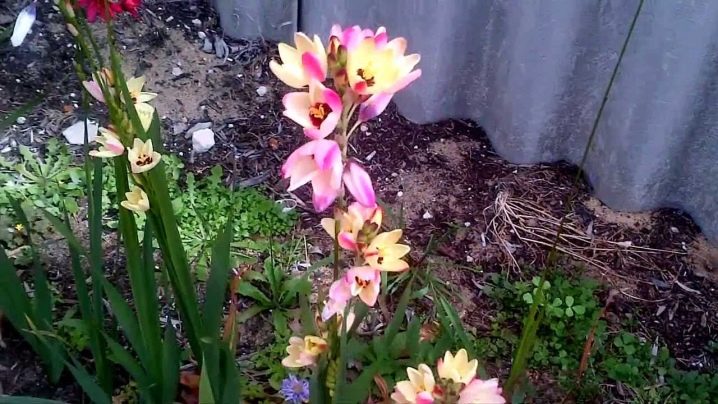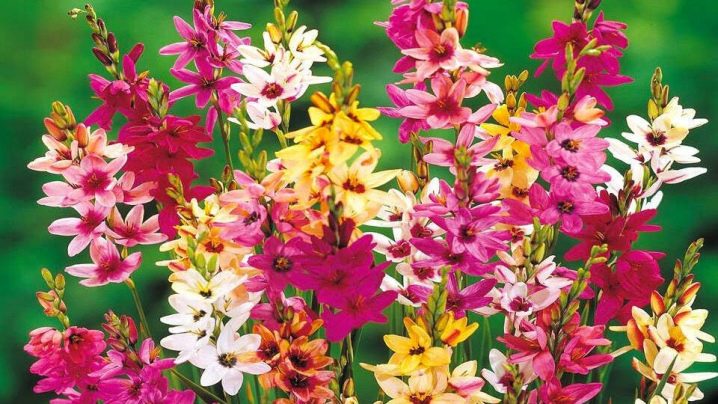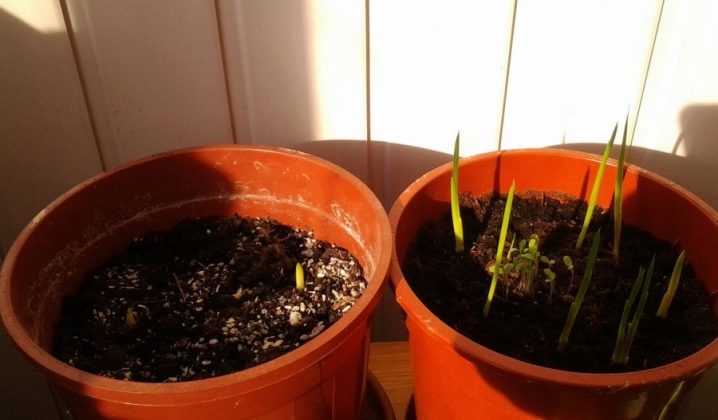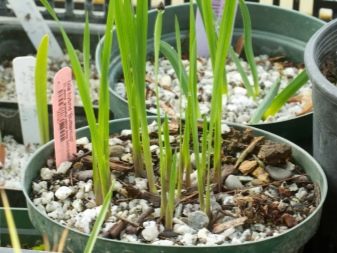What is Ixia and how to grow a flower?

Ixias are not as popular as irises, but they are also very attractive. They are delicate and exotic, very decorative. Let's see what is Ixia, and how to grow this flower originally from the Cape of Good Hope.

general description
Ixia is a perennial flower 30-45 cm high, some species can reach 60 cm. The flowers are regular, with 6 petals, symmetrical, 2.5 to 5 cm in diameter, collected in inflorescences of 10 flowers. The color of the corolla is bright, varied: red, pink, yellow, crimson, lilac, white. There is a dark spot in the center of the corolla, which adds drama to the look of the plant and makes it memorable. The leaves of the plant are long and thin, belt-like, xiphoid or lanceolate. Underground organ - medium-sized bulbs with a diameter of 2.5-5 cm.

Ixia blooms in late spring or early summer. In the open field, it can bloom in August. The flowering period depends on the time of planting: the bulbs planted in autumn bloom in early spring, planted in May - late summer. Flowers open only in the sun. Flowering lasts 2 to 4 weeks. The flower stands perfectly in cut, 10-15 days without losing its appearance. The flowers have a faint characteristic scent. It attracts bees. Ixia is not a species, but a genus. The genus includes 40-60 species. The genus belongs to the Iris family. The homeland of all Ixians is the Cape region, southern Africa.


The best species and varieties
Ixia is a popular garden flower, so there are many hybrids with a variety of colors. They all belong to the species Ixia hybrida, but sellers often omit the word hybrida. Modern varieties and mixtures of varieties are represented by the following options.
- Ixia "Venus" (Ixia Venus). Up to 30 cm tall, flowers are scarlet, bright.

- "Blue Bird" or "Blue Bird" (Ixia Blue Bird). The flowers are pure white, with a violet-purple center and a blurred stripe in the center of the petals, height - 40 cm.

- "Castor" (Ixia Castor). The flowers are very bright, blazing pink, tropical, collected in abundant clusters. Up to 50 cm.

- The Emperor series: Yellow Emperor and Rose Emperor. Height - 40-50 cm. In the yellow variety with petals, a large black-brown spot in the center contrasts very nicely. Rose Emperor has pure pink flowers, the spot in the center is small, dark pink, similar to a shadow or thickening of color. Both varieties are very different in mood, but bloom very profusely.

- "Giant", "Giant" (Ixia Giant). A very lush variety, reminiscent of tuberose. Height - up to 60 cm. Flowers are pure white. The spot in the center is inky magenta, with a bright magenta rim. The stamens are bright yellow.

- "Spotlight" (Ixia Spotlight). Very similar to Giant. The same flowers, the color of the petals is pure white, the spot is dark purple, in contrast to the white color it seems very bright, on the petals there are light purple stripes, more noticeable on the back of the corolla. Sometimes there is a slight purple thickening at the tips of the petals. White-cherry buds. Height - 40-50 cm.

- "Mabel" or "Mabel" (Ixia Mabel). Up to 60 cm, flowers of very bright color - magenta or fuchsia pink. In the shade, the flowers take on a purple hue. The flowers are not large, but the brushes are abundant.

- "Hogarth" (Ixia Hogarth). The flowers are creamy, complex shades, with greenish and yellowish backs. The center of the flowers is black. Height - 50 cm.

- Ixia Panorama. Height - 35-50 cm, flowers are pale pink, with a red spot in the center.

Biological species are also grown in gardens, many of them are very beautiful.
- Spotted (Ixia maculata). A short plant, a maximum of 40 cm, the flowers are bright: orange, yellow, pink, medium-sized, in the center there is a very dark brown spot. The inflorescences resemble candelabra.

- Chinese (Ixia chinensis). It is very rare, included in the Red Book. The flowers are very attractive, resemble tiger lilies, orange or yellow with brown spots, collected in loose panicles of 12 to 20 flowers. The plant is tall, can grow up to 1.5 meters.

- Eastern (Ixia orientalis). The cutest variety with flowers in very delicate shades of pink or white. There is no dark spot in the center. Low.

- Green-flowered (Ixia viridiflora). Flowers of an amazing turquoise shade with an ink spot in the center. Plants are tall, up to half a meter, narrow, create beautiful verticals in the garden.

- Fragrant (Ixia odorata). The flowers are large, very pure and bright yellow. The inflorescences are quite dense, from a distance the spots of yellow flowers look juicy. This is the most fragrant variety. Other ixies also have a scent, but it is weaker.

All hybrid varieties are most often sold in multi-colored mixtures: they are designated as "Mix", Mix.
Landing features
The soil for Ixia should be nutritious and very well-drained. At the landing site, remove all the soil to a depth of 35 cm and fill in the prepared soil: garden soil - 2 parts, well-rotted compost - 2 parts, neutralized peat - 0.5 parts and coarse sand - 1 part, mineral fertilizers for flower crops. The acidity of the soil should be neutral - 5.5-6.5 pH. The plant loves the sun, but it is better to choose places with a bright, but not burning sun.

Scorching direct rays can cause burns. It is necessary to plant so that the bulb sits at a depth of 5 cm. The bulbs are planted in the spring, at a soil temperature not lower than + 8-10 ° C. The plant will not survive even light frosts, therefore, in the Urals and Western Siberia, it can be planted in open ground not earlier than the beginning of June. In regions with an earlier spring, they are planted in April-May. In areas with mild winters, Ixia are planted in autumn, in November.

The distance between the bulbs is 5-10 cm, but the peculiarities of the specific bulbs must be taken into account. As a general rule of thumb, the distance between the bulbs should be 2 times the diameter of the bulb itself.
The nuances of care
Ixia is thermophilic, therefore, it is grown outdoors all year round only in regions where there are no negative temperatures in winter. In all other regions, the plant is dug up for the winter. You can grow the plant at home in a container and in a pot. For growing in a flower bed, choose a sunny open place. Do not choose clearings where during the day there are shadows from buildings, trees, bushes or taller plants. The culture is sun-loving. The quality and duration of flowering directly depend on the amount of sun.


Watering and feeding
Watering immediately after planting the bulbs is moderate, then gradually increases. After the end of flowering, watering is greatly reduced. Water for irrigation should only be warm. On hot days, watered 1-3 times a week. After the end of flowering, watering is gradually reduced. At first, up to 1 time per week, and by August 1-10, watering is completely stopped. Ixii love sprays, warm showers. During the period of active growth, daily spraying in the evening is useful.


They are fed 3 times a season with a universal mineral fertilizer for flower crops: in the phase of the first leaf, 4 leaves each, during the period of bud formation. You can use humic dressings, potassium nitrate and magnesium sulfate.
Wintering
You need to dig up the bulbs at the end of summer, when the foliage is completely dry. This usually happens in August. The leaves are cut, the bulbs are allowed to dry in mesh containers for 2 days. Then they are kept in a weak solution of potassium permanganate for 20 minutes and dried again.Sprinkle with a mixture of sand and peat or fresh sawdust. Ixii planted in containers are simply transferred to suitable premises. Store the bulbs at a temperature of + 8-10 ° C. The air should be dry, no more than 65% humidity. Can be stored in cool rooms or refrigerated. The temperature should not fall below 0 ° C. The bulbs are examined twice a month.

In the southern regions, planting for the winter is prepared, as in the case of any other bulbous: all plant residues are removed and burned, the soil is slightly loosened and mulched with a thin layer of sawdust, straw or foliage.
Reproduction
Most often, Ixia is propagated by children from corms. Children are separated from the maternal corms in the fall. Store in the same way as large onions. They bloom after 1 year. If the bulbs did not give children, but the plant needs to be propagated, the bulbs can be divided. It is important to ensure that each section has a kidney and a root. The slices are dipped in crushed charcoal. Delenki are planted as ordinary bulbs, with the sharp ends up. After 14-17 days, the cuttings take root.

Plants grown from seeds will bloom for 3 years. Seeds are sown in a mixture of sand and peat (in equal parts), sprinkled with a 5 mm layer of soil, watered with warm water. Cover with foil and place under a phytolamp. Plants need at least 16 hours of daylight. The plant dives when the sprouts reach 3-4 cm, and after 4 months the bulbs will form: they can be planted in the spring in open ground or grown to the desired size in containers.

Diseases and pests
This beautiful flower is not very attractive to pests and pathogens. Ixiae get sick very rarely, they have excellent immunity. From hypothermia, stagnant water, dampness, bulbs can rot. With a lack of light and minerals in the soil, the leaves will turn yellow. The plant will immediately report a lack of moisture with wilting leaves that have lost their tone. Sometimes aphids can settle on the leaves of Ixia. They get rid of it with the help of "Fitoverm", "Entobacterin", "Tanrek". These drugs will not work immediately: after 3-4 days it will become noticeable that the number of insects has decreased. Reprocessing may be required.

You can use regular liquid soap for aphids. A liter of water will require 4-5 tbsp. spoons of soap. The affected leaves are sprayed with a soapy substance, and after 2 days they must be washed well under running warm water.
Use on flower beds and containers
The flower garden in the garden is positioned so that Ixia is clearly visible during the month: from mid-July to mid-August. It is during this period that Ixia blooms. In pot and container culture, flowers may appear earlier - in late spring. Ixii are medium-sized plants, so they look best in group plantings. The tallest varieties, for example, green-flowered ixia, are often planted in mixborders of herbs and ornamental grains. Low-growing hybrid varieties are ideal in small, bright flower beds or in clusters in a rock garden.

Since the flower is sun-loving, the best flower bed is a carpet one, consisting only of ixia or flowers of the same height. Ixia plants look great, planted in rows in lawns, along paths or in containers on terraces. Ixia are combined with any plants, it is only important to make sure that taller flowers do not block the sunlight with them. It is very good in planting with other small-bulbous plants, in flower beds, where the severity of lines and the effect of a flower carpet are important.
For information on how to plant and care for Ixia, see the next video.







































































































The comment was sent successfully.